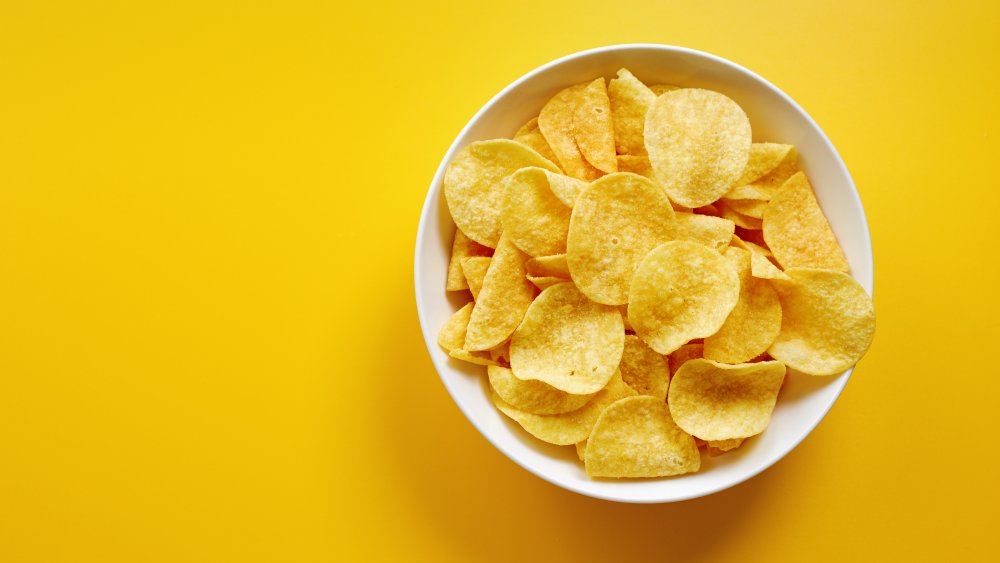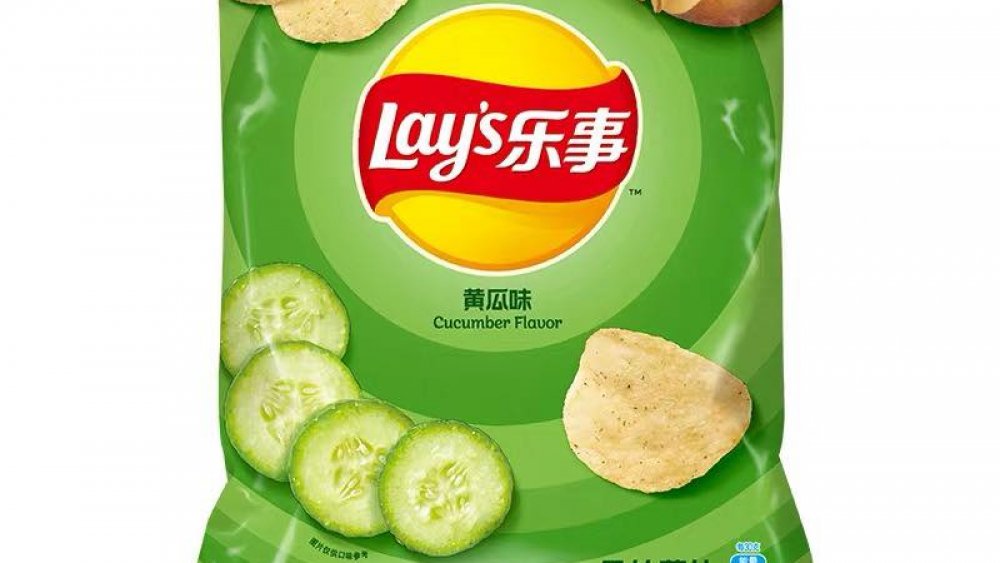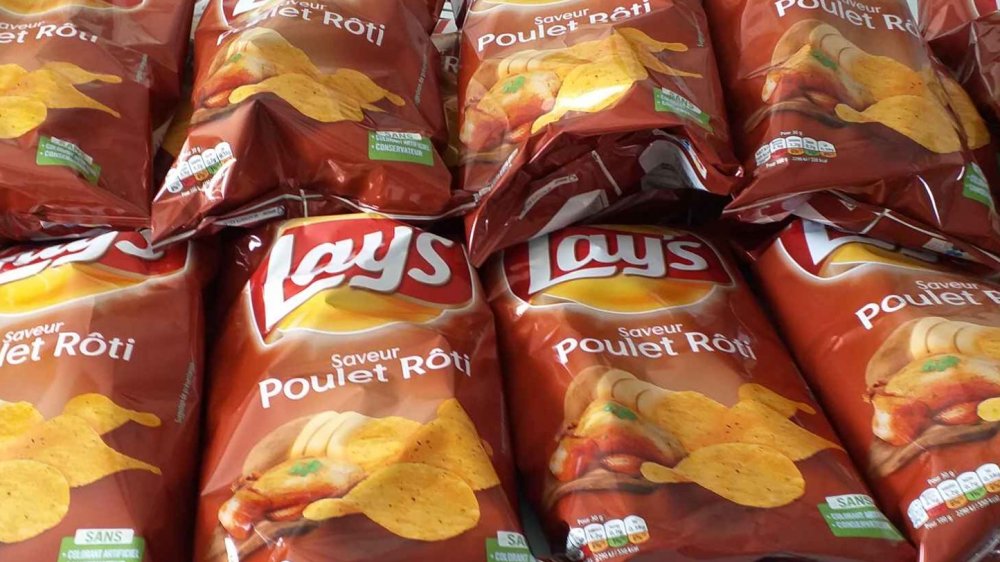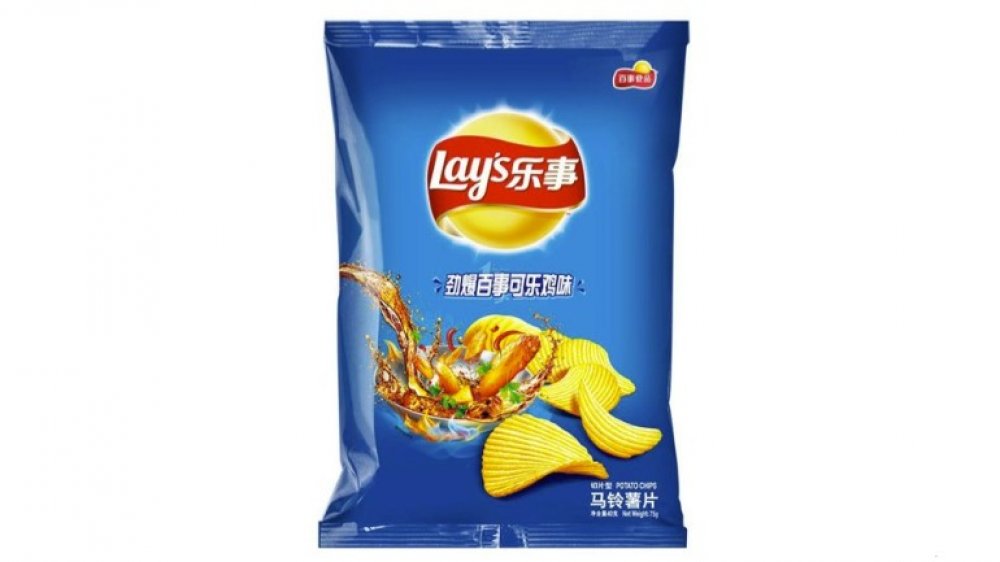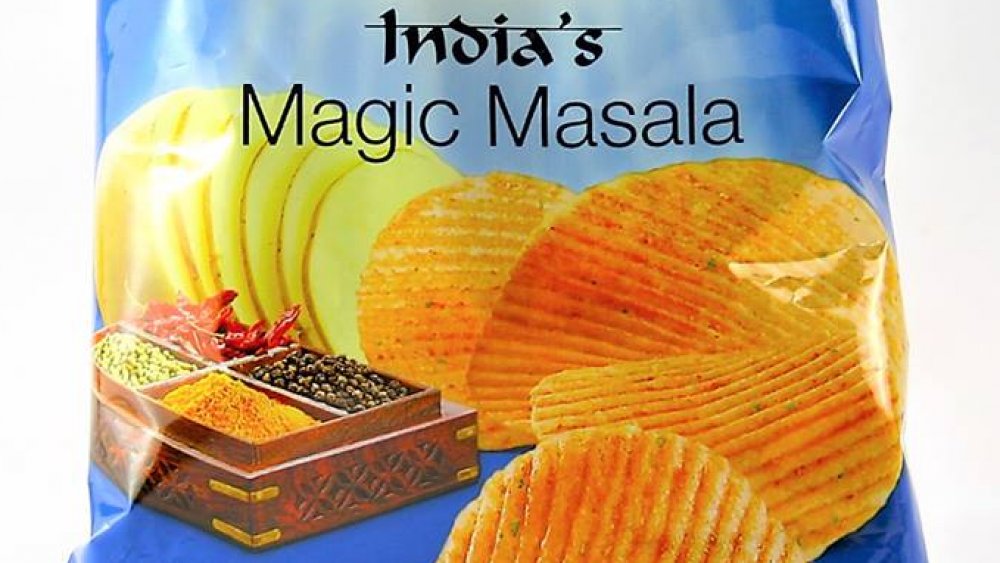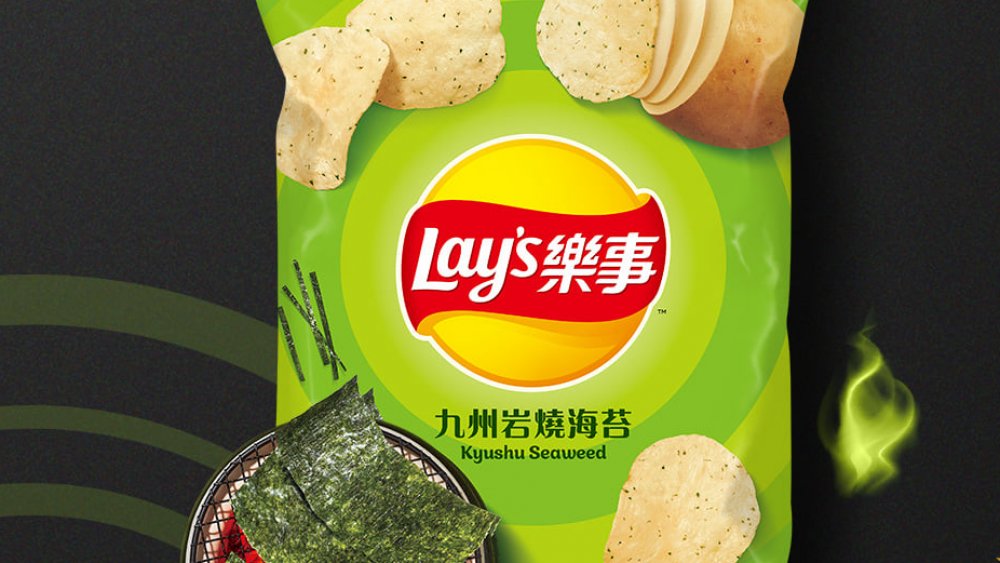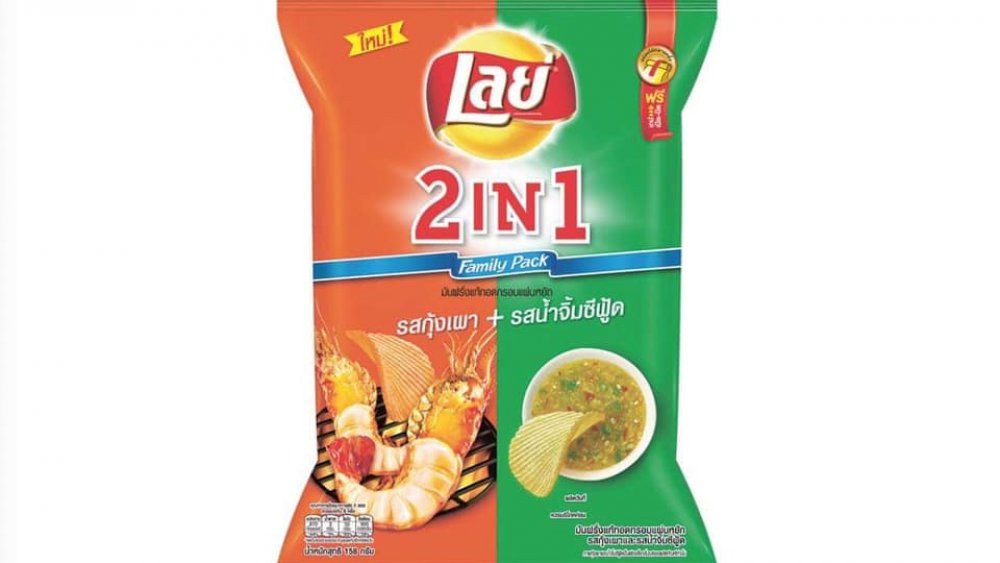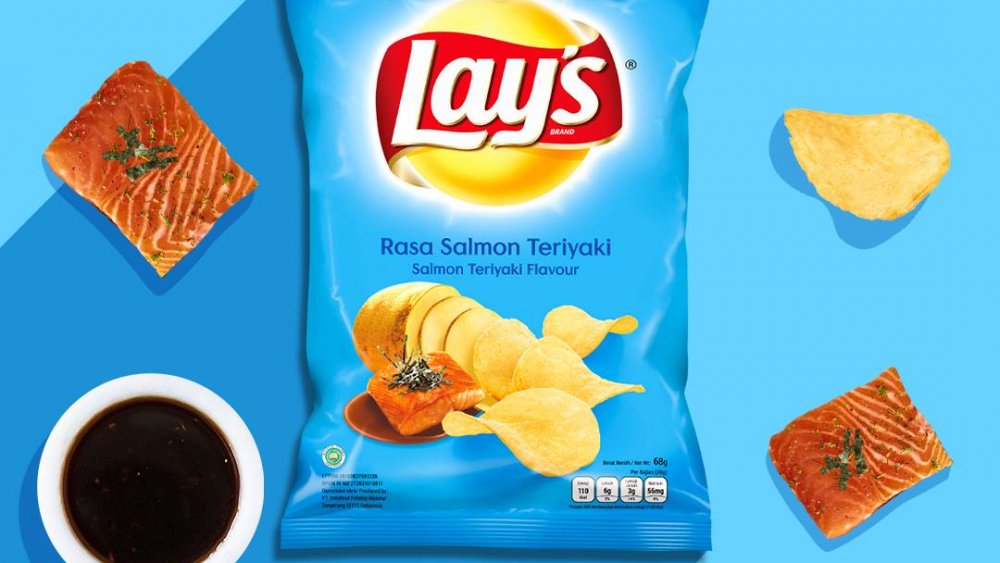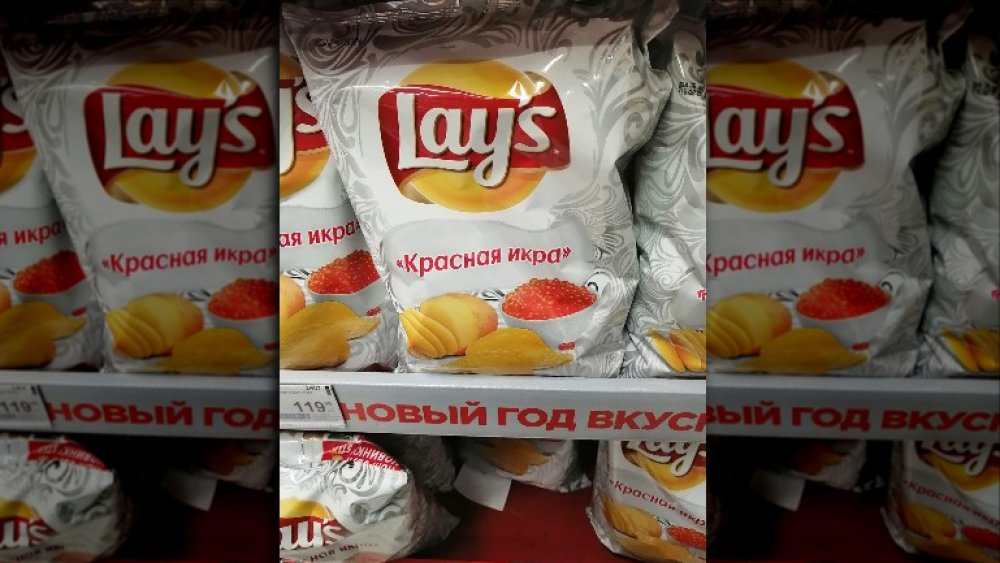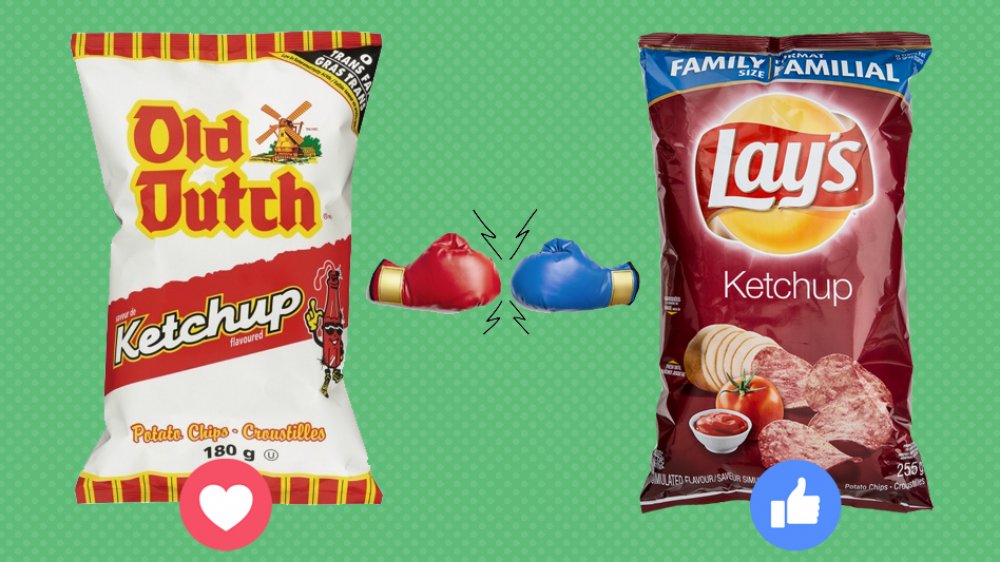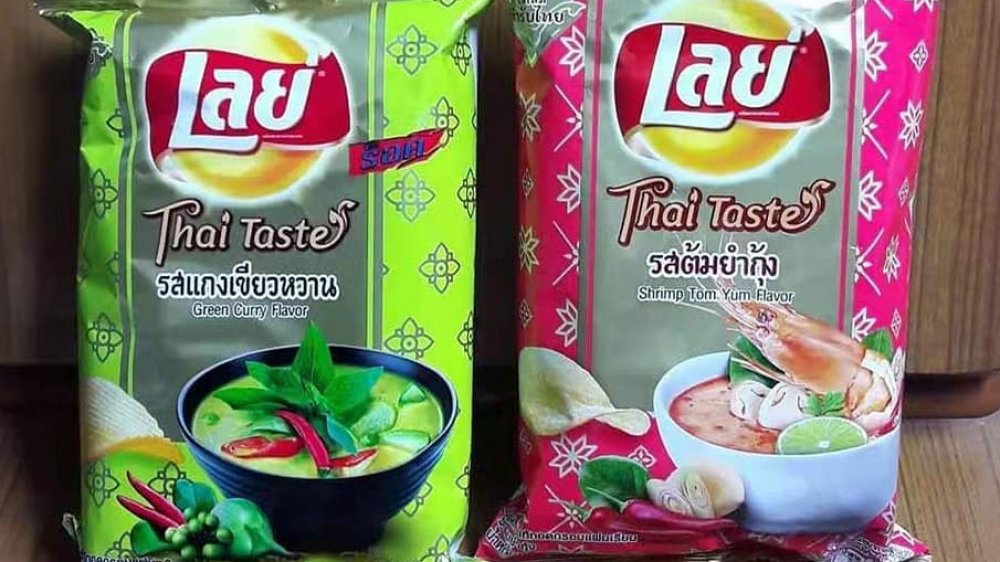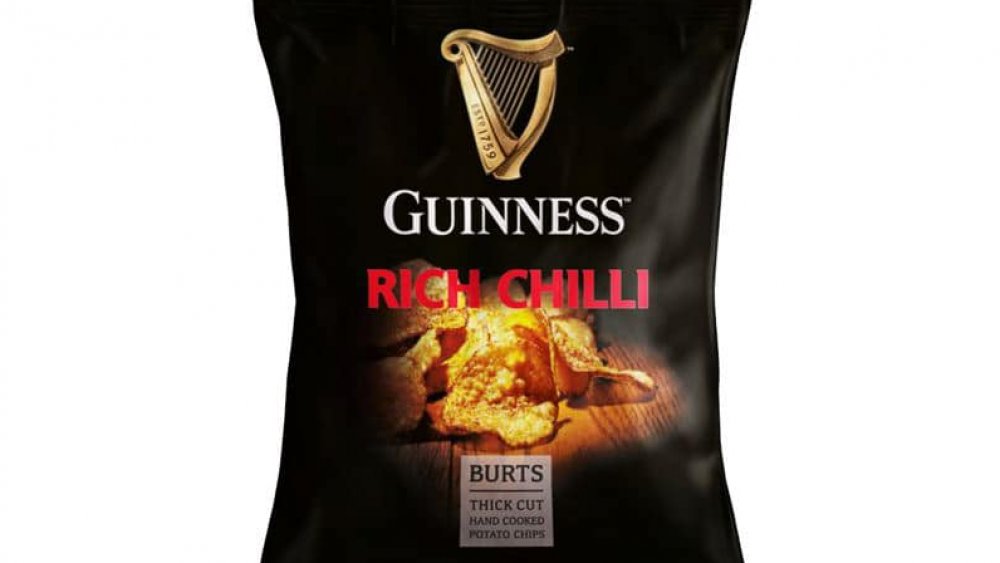Chip Flavors We Wish Would Come To America
We may receive a commission on purchases made from links.
There are days when America seems to have it all — at least when it comes to chips. In a National Geographic interview, Ali Payne, vice president of global snacks innovation at PepsiCo (owner of Lay's, the largest manufacturer of chips on the planet), claims that America has the largest variety of flavors of any nation on Earth. If that's really true, however, why are the chip choices on our supermarket shelves are so ... bland?
As observed by Mental Floss, when it comes to chip flavors, Americans seem to be weirdly timid. Aside from the occasional bag flying a flavor freak flag — we're talking the limited edition outlier that was Lay's Chicken and Waffles chips — choices tend towards staid and standard. This risk aversion is all the more apparent when you take a look at the wildly adventurous chips on sale in other countries in Asia, Europe, and evenly supposedly boring Canada.
In search of chip inspiration, we took a virtual world tour in order to round up some of the most intoxicating flavors on the planet. Our criteria was not merely to make a listicle of the most outrageously exotic options around (Cajun squirrel anyone?). Exotic is great, but the chips we tracked down are rumored to taste so good that you'll be motivated to log onto Amazon and import yourself a few bags. These are the Chip flavors we wish would come to America.
Fruity chips
Sometimes it pays to think outside the box, or — in the case of chips — the bag. That's what Lay's did as part of its attempt to hook Chinese consumers on one of America's most iconic salty snacks.
One of the key tenets of Chinese Taoist philosophy is the duality of yin and yang. This principle in which opposites — hot and cold, sweet and sour — complement each other permeates many aspects of Chinese culture, including food.
Traditionally, the Chinese notion of a balanced meal merges yin and yang foods. Yang foods — such as potatoes — are dry and grow in the soil. Their coloring tends towards warm oranges, yellows, and earth tones. Conversely, yin foods are moist, grow in or near water, and come in cool green-blue hues. Viewed from a yin-yang perspective, it made philosophical (and economic) sense for Lay's to create chips in fruity yin flavors such as blueberry, kiwi, and cucumber (yes, technically, or at least botanically, cucumber is a fruit!).
Lay's adherence to Taoist principles paid off. Blueberry and cucumber chips are supposedly best sellers. Even highly dubious foreigners, initially leery of such "weird" flavors, uniformly succumb to the refreshing contrast of blueberries' sweet-sourness and chips' saltiness. While their sweetness is more subtle, "cool" cucumber chips are deemed to be equally refreshing. As one American reviewer who rated them four out of five said, "If someone had a bowl of these at a party, I would definitely eat them."
Roasted chicken chips
What's the ideal sidekick to a succulent roasted chicken? If an image of a crispy potatoes immediately invades your brain you'll agree that it's only natural that roasted chicken flavored chips would have a loyal following. What's interesting is that the loyalty is seemingly most fervent in the haute cuisine stronghold of France where Lay's poulet rôti chips have become "a thing."
In reality, it's a French "fast food" tradition to pick up a fresh rotisserie chicken in markets and butcher shops around the country. Lay's invention takes the convenience, not to mention the crunch factor, a few steps further. For extra cachet, it even added a version with thyme to the mix.
Of course, the French didn't invent roasted chicken (although in China, where Lay's created a French chicken flavor, there would appear to be some doubt). Nor did they invent roasted chicken chips. In Britain, Walker's (owned by Lay's parent company, PepsiCo) also sells a roast chicken crisp that reviewers swear is akin to biting into a bonafide rotisserie chicken. Lay's Canada also makes roast chicken chips although, perhaps due to the relative geographic proximity to both Britain and France, they're mysteriously only available in Canada's Atlantic provinces.
Cola chicken chips
Initially, the thought of cola and chicken potato chips sounds fairly unappetizing, if not sort of gross. However, bear with us by conjuring up a meal of crispy, barbecue chicken wings chased by glass of sweet cola. Not so bad, right?
Such was the conclusion reached by inventive Chinese cooks who took this chicken-cola compatibility to the next level of proximity when they created Coca-Cola chicken wings. When China first opened its market to foreign companies in 1979, Coca-Cola was the first to set up shop. Soon after, Coca-Cola chicken wings had become all the rage. The most basic version of this recipe involves nothing more than pouring the contents of a can of Coke over wings frying in a wok, then boiling the liquid down until it forms a thick, caramel-rich, barbecue-style sauce.
Coke was already well entrenched in the Chinese market when latecomer Pepsi arrived on the scene (in 1982). As part of an offensive strategy against its rival, PepsiCo (which owns Lay's) launched a two-pronged offensive by rolling out Lay's Cola Chicken chips (featuring Pepsi, of course). According to Business Insider the unusual new flavor was a "smash hit." Many Chinese chip fans agreed with Weibo user Mathilde TT who confessed, "Couldn't imagine Lay's Pepsi chicken flavor would taste this good." The unusual flavor also tapped into the taste buds of Western samplers, who have compared it favorably to a barbecue chip with an appealingly sweet aftertaste.
Masala chips
Upon its arrival in India in 1995, Lay's adapted the same successful formula it had used to seduce Chinese consumers: introducing Western snack food via traditional flavors. In India, the winning flavor was masala, a blend of regional spices whose countless variations are comparable to the vast number of chip flavors on the planet.
Indian author Renuka Vasu gives kudos to Lay's for its savvy strategy, acknowledging how masala chips won over India's skepticism of Western influences and became the de facto snack of choice at events as varied as cricket matches and birthday parties. Among the heady spices in Lay's Magic Masala chips are: onion, chili, dry mango, coriander, ginger, garlic, black pepper, turmeric, and cumin. Vasu describes the experience of biting into one of these "magic" chips and encountering a commotion of flavors — spicy, salty, sour, and sweet — that reflect India itself.
Candy Critic praised the chips for radiating a very Indian style of heat, described as a stealthy burn that quickly cools as opposed to an intense blast that lingers. The reviewer recommended them for "anybody who wants to up their spice threshold without blasting their socks off." Meanwhile, when Indian YouTube star Anisha Dixit took a bag of Magic Masala chips for a test drive on young American palates, all her chip-loving guinea pigs highly endorsed the flavor, awarding scores that ranged from seven to 10 out of 10.
Seaweed chips
Chips aren't really something you turn to when you're in search of healthy fodder. That said, what if the chips you reach for contain one of the world's most vaunted superfoods, i.e. iodine, iron, vitamin, antioxidant and fiber-rich seaweed? Although seaweed has become fashionable (and fashion-worthy) in the West, it's been part of the South-East Asian diet for millennia. This explains why Japanese, 10 percent of whose diet consists of seaweed, boast the world's highest life expectancy. It also accounts for why you'll find tons of seaweed flavored chips throughout the region.
Seaweed chips are usually flavored with nori, best known as the paper-thin sheets of green that encase rice in sushi. (For the culinary record, Mental Floss recommends pairing seaweed chips with sushi for a "mind-blowing" combination of flavors and textures).
Aside from many local brands, Lay's traffics in several seaweed options, among them Lay's Kyushu Seaweed chips, that receives rave reviews from Westerners. Insider found them to be "delicious," with pronounced seaweed flavor in both the chip and the seaweed flakes sprinkled on top. Grocery Gems commended the mélange of sweetness, salty soyness, garlic, and faint fishiness, all of which added up to an "incredibly moreish and satisfying" chip experience.
Despite near unanimous claims of scrumptiousness, if you still want to pretend you're investing in a bag of seaweed chips for the health benefits, you can cling to the reassuring scientific fact that a "little (seaweed) goes a long way".
Seafood chips
With seafood so prevalent in local diets throughout Southeast Asia, it's hardly surprising that aquatic critters have swum their way into the region's chips.
Thailand alone has an oceanful of enviable and impressively complex seafood flavors, many of whose natural sweet-salty tang is offset by peppery hotness. Favorites in this vein include Lay's Rock Hot Chili Squid chips, described by Eat This ,Not That! as the next best thing to a plate of fried calamari. An American who bought a bag via Amazon, described the immediate surge of hot chili that segues into squid as an "awesome flavor" that (s)he wished existed in the U.S.
Lobster Hot Plate is another of Lay's Thai offerings that earns raves. These crustacean-flavored chips ranked high at PopSugar where the chip-tasting jury was impressed by an initial creamy mildness that was followed by a much-appreciated spicy kick.
Crustaceans and chilis also co-star prominently, and inventively, in Lay's 2-in-1 Grilled Shrimp and Seafood Sauce chips. As YouTrip points out, 2-in-1 chips can be like a lottery in that when you reach into the bag, you're never sure which flavor you'll get. Luckily, in the case of these chips, the tastes of both sweet-salty shrimp and pungent green chili sauce are winners. A team of chip reviewers at Chicago Reader praised the twofold flavor concept as being a "game changer in chip innovation."
Salmon chips
While you don't have to be a hard-core yogi to wrap your head around the notion of seafood and seaweed chips, fish-flavored chips might give you whiplash. That said, many fish-adverse chip fans might warm to the idea of salmon chips, which have a loyal fan following in South-East Asia.
Ranked among the top consumers of fish on the planet, Japan's mostly devoured fish is salmon, which explains the origin and popularity of Lay's Rasa Salmon Teriyaki chips. Also Japanese, and much more interactive, are Jack'n Jill's Salmon Sushi chips with Wasabi. To fully enjoy these chips involves some work. When you tear open the chip bag, you'll encounter two packets, one containing chips and the other wasabi powder. You then need to tear them open, pour the contents into the original bag, and shake. An Australian reviewer praised the final result of her labors as decidedly tasty (if a little light on salmon sushi flavor).
Perhaps most likely to please American palates are Lay's Cream Cheese Salmon chips. Mental Floss cites this chip as a prime example of Thailand bringing it's A-game and compares it to the joy of repeatedly biting into a very crispy New York City bagel with all the trimmings.
Just as you think things couldn't get crazier, while potato chips manufacturers are simulating salmon, a British start-up called SeaChips is using dried salmon skins, which would otherwise go to waste, as a sustainable (and healthy) alternative to potato chips!
Red Caviar chips
From salmon, it's not too much of a leap to red caviar. which happens to be a major chip flavor in the world's caviar capital, Russia. Unlike the stratospherically expensive jet black caviar made from sturgeon that was gobbled up by Russian monarchs as early as the 13th century, caviar made from glistening red salmon roe didn't make an appearance at Russian tables until the 18th century — coincidentally, around the same time as potatoes.
During the Soviet era, red caviar production was government controlled and the delicacy was subsequently very difficult to obtain. In the 1970s and '80s, those who had the proper connections enjoyed flaunting their privilege by flagrantly eating caviar sandwiches. For better or for worse, times have changed. Today, most Russians can afford to buy a bag of Lay's Red Caviar chips. In doing so, they subversively combine one of the planet's most highbrow edible treasures with one of its most lowbrow pig-out pleasures, a fusion described by the fancy folk at Town & Country as "a match made in food heaven."
According to chip tester Zachary Tracer, Lay's version of this high-low pairing tastes exactly the way it should, i.e. like fried potatoes, salt, and caviar. Despite the authenticity of the flavors, Tracer nonetheless cops to missing the "distinctly slimy" texture of fish eggs.
Ketchup chips
It's somewhat ironic that while the U.S. gave birth to two modern culinary touchstones — potato chips and tomato ketchup — it took a Canadian to dream up the idea of fusing the two together into one tangy crisp. It all started in the experimental '70s when Canadian chip manufacturer, Hostess (today owned by Lay's), decided to roll out a series of chips in psychedelically-hued fruity flavors. Grape, orange, and cherry chips bombed. But the tomato-based ketchup flavor struck a chord in the collective Canadian appetite becoming, in the words of food writer Chris Nuttall-Smith, one of the most revered of all salty snacks.
These days, Canadian can choose from countless brands of ketchup chips. However, Nuttall-Smith swears that the best are made by Lay's, which like many of its brightly red-dyed rivals, are only available in Canada. The marvel of Lay's chips is that, instead of tasting like ketchup, they taste like ketchup's component ingredients — stinging vinegar, sweet tomatoes, lip-blistering salt — minus the wetness.
If ketchup chips are so delicious, why aren't they available south of the 49th parallel? Katie Ceclan, senior director of marketing at Lay's in the U.S. confessed to the Chicago Tribune that ketchup has been on the chip list (imagine such a thing!) for many years, but that Lay's is waiting for an uptick in popular demand before it relents and gives the people what they want.
Breakfast chips
They say that breakfast is the most important meal of the day. But why spend all the time and effort of cooking up a storm at home or lining up around the block for brunch when you can get all that multi-flavored breakfasty goodness in a single, compact potato chip (no washing up or dressing up required)?
Since potatoes in various guises figure prominently in most self-respecting breakfasts, it's only logical that breakfasts should figure prominently in a potato chip. Like many of the world's most logical innovations, Pringle's Eggs Benedict chips originated in Japan. According to Aaron's Food Adventures, this seemingly simple chip manages the ambitious feat of fusing an initial eggy taste with subsequent shots of hollandaise sauce and Canadian bacon. After sampling one, a reviewer at SoraNews24 said it was like a waitress had just served up a portion of Eggs Benedict at an NYC café, adding that Pringles even managed to replicate the distinctive flavor of an "oozy, plump, almost raw" egg.
Breakfast chips have also won raves — as well as prizes — in the West. In 2009, Builders Breakfast was the winner of Walkers' "Do us a Flavour" competition in which mere British mortals suggest manufacturable flavors. Modeled after a classic English breakfast of eggs, bacon, buttered toast, and roasted tomatoes, the chips were sold for about a year before being unceremoniously discontinued. Fans were so distressed that they launched a Change.org campaign to bring back "the greatest crisps ever created."
Soupy chips
Is there anything more comforting than a bag of chips? How about a bowl of soup? So what if one is cold, thin, and crispy while the other is hot, voluminous, and makes a splash? There are times when you turn to one or the other for succor and sustenance, unaware that in an ideal world (or parts of Asia), you can have your soup and crunch it too.
Spiked with fragrant and pungent seasonings, Asian soups practically beg to be transformed into chip form. Lay's has been more than merciful by launching soupy chip flavors praised by global chip devotees. Lay's Beef Noodle chips were hailed by Insider for their strong broth flavor, pronounced hints of beef, and "tasty" spices sprinkled on top of the chip itself. The folks at That's raved about Lay's Numb & Spicy Hot Pot chips, commending Lay's "creative geniuses" for successfully distilling the zest of Chonqing-style broth and fire of Sichuan peppercorns into a single "bold and invigorating" crinkle-cut chip. Meanwhile, Chicago Reader's chip jury fell unanimously hard for Lay's Shrimp Tom Yum chips, applauding the complex stew of flavors including lemongrass, kaffir lime leaves, and shrimp.
Those who prefer sweetness to spice might enjoy Borsch chips (which are weirdly an Asian as opposed to Eastern European thing). Since beet chips are already alive and well on North American supermarket shelves, borscht chips seem like a no-brainer, even if one sampler compared the taste to ketchup with a light hint of topsoil.
Boozy chips
As if chips and alcohol weren't already sufficiently addictive on their own, some genius British mixologists are concocting chips with the flavors (if not the alcohol content) of your favorite poison.
Among the many possibilities, the most worthy candidate for an evening of self-medication appears to Burt's Guinness chips. Infused with roasted barley and hops (not to mention cocoa), the chips are lauded by The Daily Meal for coming impressively close to the rich, malty taste of the legendary Irish stout. Those in need of a stiffer drink (or chip) might want to try Aldi UK's Gin & Tonic crisps. One YouTube reviewer praised the use of high quality potatoes and refreshing lime kick while lamenting the somewhat watered down gin and tonic. Even with the possibility of a hangover being negligible, a teetotaling English cop who branded the chips "totally irresponsible" incurred serious Twitter backlash.
Beer and gin chips are fine for everyday. However when year-end holidays roll around, Brits seemingly want to deck the halls with festive chips — at least British supermarkets think they do. After Tesco launched Prosecco and Elderberry chips, Marks and Spencer upped the ante with Winter Berries and Prosecco with Fizz and Sparkle chips (which were actually sprinkled with pink sparkles that fizzed on your tongue!). Despite the special effects, Twitter reaction ranged from "This is all kind of wrong" to "Go home Tesco. You're drunk." In the end, when it comes to chips, maybe it's best to stick with beer.
